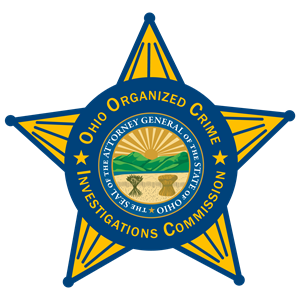
The Ohio Organized Crime Investigations Commission would be the last crime-fighting group to crow about the many wins it has helped engineer through its 33-year history.
The commission, after all, prefers to thrive quietly behind the scenes, where it builds task forces from members of different law enforcement agencies to investigate crimes that can be entrenched and widespread.
Think drug running, money laundering and human trafficking but also mortgage fraud and public corruption.
“Most people have no idea we exist,” said Rocky W. Nelson, executive director since 2011. “I served on the first task force in the late ’80s-early ’90s as a detective with the Union County Sheriff’s Office. And I still didn’t realize how OOCIC was designed with local law enforcement in mind.”
The commission’s under-the-radar profile belies the contributions it has made to communities statewide.
“Without (the OOCIC task force), our drug epidemic would have been twice as bad as it was,” state Rep. Phil Plummer, a former Montgomery County sheriff, said in recounting problems with Mexican drug cartels.
“We’d be in trouble, trust me.”
As a member of the commission, Portage County Prosecutor Victor Vigluicci has seen the results firsthand.
“Some of the most successful task forces in this state’s history have come from OOCIC,” Vigluicci said.
In 2018 alone, OOCIC task forces seized $4 million in currency and $57.5 million worth of drugs, said Deputy Director Matt Hilbert. The haul included 141 pounds of fentanyl, 411 pounds of meth, almost 2,000 pounds of marijuana and more than 59,000 prescription pills. Also, 585 people were indicted and 77 victims of human trafficking were rescued.
The commission, created by the Ohio General Assembly in 1986, serves as a facilitator for the local, state and federal law enforcement agencies and prosecutors who join its task forces. It provides special investigative powers as well as equipment, funding and other assistance.
Local control
An OOCIC task force is usually led by the sheriff’s office or police department that proposes it to the commission, allowing those who know their geographic areas best, and their problems best, to make the decisions.
That local control has been lauded as key to the commission’s enduring success.
“If you run it locally, you have the local trust of citizens reporting to us,” Plummer said.
Deputy Chief Tim Becker of the Columbus Division of Police, which is active in several task forces, agreed.
“Having our own supervisors command these initiatives has been very valuable, especially since we are the largest agency in our region and contribute many personnel,” Becker said. “This allows the task force to operate within the core values of our agency, while simultaneously embracing a mission larger than our city.”
It also enhances the chances for success, he said.
“A task force serves as a force multiplier, allowing our personnel to accomplish much more than they could alone.”
Fairness & efficiency
The OOCIC has seven members: the attorney general as well as six appointees — two sheriffs, two police chiefs and two prosecutors — chosen by the governor in collaboration with the AG and legislators. No more than four members can be from the same political party, which helps keep the decisions about which criminal organizations to pursue nonpartisan.
The commission, supported by a staff of 10, operates on a budget that was 10 times smaller than what the state sent to the Lottery Commission to spend on advertising contracts last year.
“The resources and abilities that OOCIC is able to provide,” said Gallia County Sheriff Matt Champlin, whose office has been a part of task forces, “are one small example of how our citizens receive a return on their tax dollars.”
He said his office, as a smaller department, has participated in task forces that led to successful prosecutions of criminals “we would otherwise not have had the time and resources to focus on.”
Valuable resources
Two of the most important resources the commission grants are subpoena power and the ability to investigate in any county included in a task force’s mission, even one outside the jurisdiction of an officer’s home agency.
That has been a primary goal since the start.
“Organized crime knows no geographical boundaries or jurisdictional limitations,” says a 1982 report commissioned by Gov. James A. Rhodes to explore how much organized crime cost Ohio. “… Law enforcement officials in Ohio, however, enjoy no such free latitude.”
Four years after the report was issued, the commission was established.
“Because the statutes that created OOCIC have the big picture in mind, it accomplishes big results,” said Vigluicci, the commission member.
Assistance beyond task forces
The OOCIC also offers its audio and video experts to help law enforcement agencies outside of task forces. For example, the Columbus Division of Police used OOCIC’s team to enhance audio or video evidence in 37 cases last year. In addition, the commission welcomes agencies to send in cold case evidence now on tapes or videocassettes to be turned into digital files, which aren’t at risk of degrading over time. Call 800-589-6622 for more information.
To find out more about how OOCIC operates, or to submit a proposal for the commission to consider for a new task force, visit www.OhioAttorneyGeneral.gov/OOCIC.
Once the OOCIC approves a task force’s creation, the help that the commission provides depends on the nature of the investigation.
The OOCIC can supply technical gear and any special training needed; it can cover confidential-informant payments and contraband purchases by undercover officers. Part of the deal, too, is workers’ compensation insurance and potentially travel, office space and phone bill payments.
Members of the commission’s staff offer legal advice, help with clerical work and investigations, and forensic audio and video analysis.
“This support is instrumental on a daily basis for the effectiveness of the detectives,” said Chief George Kral of the Toledo Police Department, which has experience on OOCIC task forces.
Trusted partner
There’s no concrete way to measure the value of OOCIC’s intangibles, such as the trust and respect it has earned from local departments.
Nelson, the OOCIC’s executive director, said he often fields calls from law enforcement officials looking for an introduction to someone in another part of the state. And he humbly emphasized that OOCIC successes rely on the relationships local law enforcement agencies build with each other and state and federal agencies.
“We’re here to build those relationships,” he said.
Indeed, Kral named nine local, state and federal agencies with which the Toledo PD has stronger ties thanks to task force participation.
“These lines of communication can only enhance the battle against the criminal element,” he said. “Rocky Nelson and Matt Hilbert should be commended for their hard work.”
Likewise, Columbus Deputy Chief Becker praised the commission staff and its leaders, calling them knowledgeable and gifted mediators.
“The ability of the OCIC task force model to exponentially increase the success of our agency cannot be credited enough,” he said.
One success story
One former OOCIC effort, the Southwest Ohio Violent Crime Task Force, was brought together to combat violent crime in the small Village of Lincoln Heights in Hamilton County, said Lt. Brian E. Stapleton of that county’s sheriff’s office.
“The village was known as a safe haven for criminals who would go unmolested by the local police department,” he said.
In addition to the Hamilton County Sheriff’s Office, agencies that participated in the task force were the Cincinnati, Woodlawn and Lockland police departments, the Ohio Bureau of Criminal Investigation and the FBI.
By its conclusion, the task force had closed over 30 murder cases, taken 92 guns off the street and arrested a Lincoln Heights police sergeant for theft in office. The village police department also ended up shutting down.
“This task force affected real change in the Village of Lincoln Heights,” Stapleton said. “This was far and away the most successful investigative unit that I have been a part of in my 23-year career.”

OOCIC Task Forces By the Numbers
(2009 – Present)
3,785
Individuals indicted on 13,134 counts
5,372
Arrests
3,782
Search warrants served
1,417
Firearms seized
555 lbs.
Heroin seized
265 lbs.
Fentanyl seized
1,321 lbs.
Cocaine seized
647 lbs.
Meth seized
64,921 lbs.
Marijuana seized
$33.3 million
U.S. currency seized
$262.6 million
Street value of narcotics seizures
1,153
Potential human trafficking victims rescued or referred to services
Note: The first seizure of fentanyl was in 2014. Tracking of human trafficking statistics began in 2013.